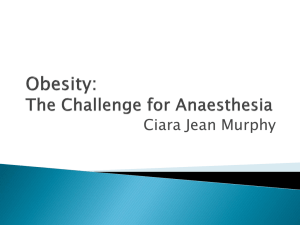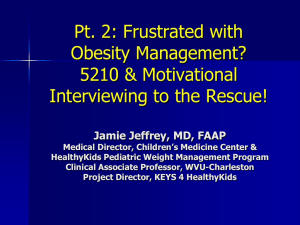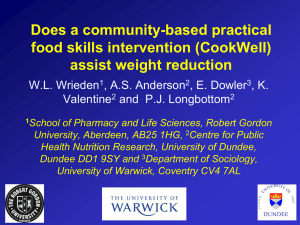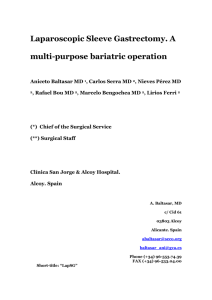David Steene - Spire Healthcare
advertisement
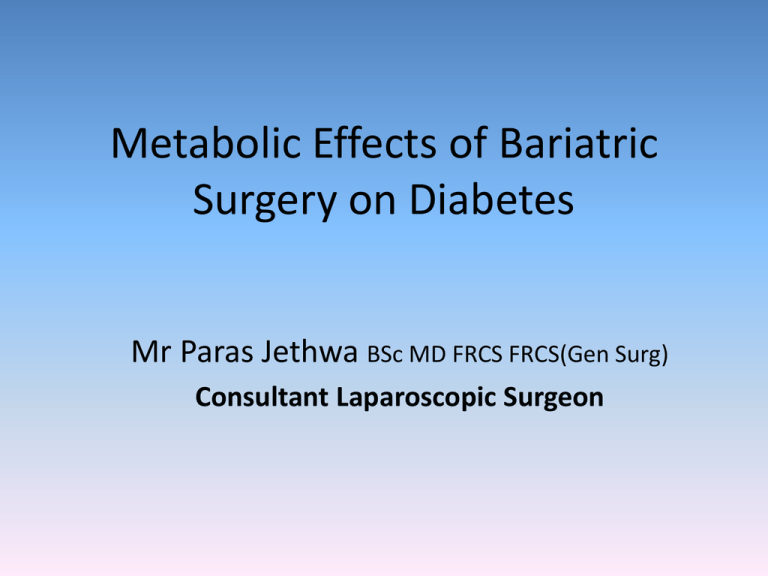
Metabolic Effects of Bariatric Surgery on Diabetes Mr Paras Jethwa BSc MD FRCS FRCS(Gen Surg) Consultant Laparoscopic Surgeon Definitions • Body Mass Index = weight/height2 < 20 = underweight 20-25 = normal 25-30 = overweight 30-40 = obese > 40 = morbidly obese • Excess Weight = Current Weight – Ideal Weight BMI > 30 1991 BMI > 30 1992 BMI > 30 1993 BMI > 30 1994 BMI > 30 1995 BMI > 30 1996 BMI > 30 1997 BMI > 30 1998 BMI > 30 1999 BMI > 30 2000 BMI > 30 2001 Worldwide Obesity Prevalence (%) 35 30 25 20 15 10 5 0 US A M EXI C O UK S L OVA K I A GR EEC E A U S TR A LI A NZ H U N GA R Y S P AIN I R EL A N D T U R K EY S WED EN FR A N C E JAP AN Obesity Related Mortality Type 2 DM • >80% have BMI >25 • 50% obese, 10%>40% • Modest weight loss helps control • BUT - 95% will fail with diet • Proposed in mid 90’s that T2DM – “Surgical disease” – Foregut hormone stimulation Surgical Options • Restrictive vs. malabsorption • Restrictive: – Generating saiety signals • Malabsorpative: – Gastric restriction – Duodenal and upper jejunal bypass • Extreme (BPD & Switch) – Only last 50cm of SB used for digestion Laparoscopic Gastric Band • Mean = 47% EWL • Best for – BMI < 47 kg/m2 – Regular meal patterns – Non sweet eaters • Mortality risk 1:800 • Morbidity risk 1:100 • 15% bands need revision Laparoscopic Gastric Bypass • Mean = 72% EWL • Best for – All BMI – Sweet eaters and grazers – Diabetics • Mortality risk 1:300 • Morbidity risk 1:75 Laparoscopic Sleeve • • • • • • • Mean = 75% EWL? Easy maintence One long suture line Poorer longterm Removes Ghrelin producing cells Mortality risk 1:400 Morbidity risk 1:100 Laparoscopic Mini Gastric Bypass • Mean = 80% EWL • Best for – All BMI – Grazers – T2DM • Mortality risk 1:500 • Morbidity risk 1:80 • Lower long term risk of metabolic complications • Extensively practiced in US MGB success What mechanisms are at work? Bypass factors • Foregut vs. Hindgut theories – Gherlin – Glucagon like peptide – Gut derived glucadonotropic signalling • Diabetic effect seen before weight loss – Clear division contributes – RYB vs. Banding for speed of control Weight loss factors • Improvements insulin action/reduced resistance • Relieve secretory pressure on ß cells • Early effect: – Calorific reduction - increase insulin sensitivity • Later effect: – Absolute weight loss glycaemic control Are the effects longlasting? • Maximum wt loss is at 1-2 years • 30-50% excess wt loss at 6/12 • 10-14 years post op - more favourable levels of : – Cholesterol – DM – HT Benefits • • • • 621 studies with 135, 246 patients Mean age - 40.2 years Mean BMI - 47.9 80% Female • • • • 56% EBWL 78% resolution of diabetes BPD>RYB>LAGB Effect static at 2 years • Case controlled prospective study • Surgery v control • 4047 patients • 99.9% follow up • Average 10.9 year follow up • Prospective SOS trial: – Glucose/lipids/BP • 10.9 year FU - 30% mortality Non T2DM effects • SOS study • 50% reduction in IHD • 85% reduction in sleep apnoea • Life expectancy improves up to 89% • Up to 40% reduction in premature death • 60% reduction in cancer deaths • Fatal IHD halved Resolution / improvement of comorbidities 90 80 70 60 50 40 % amelioration 30 20 10 0 DM Lipids HT Sleep Apnoea Prognostic factors for DM remission • Type of op • Pro: – Early rapid weight loss – Preoperative insulin dose • Against: – – – – Diabetes dutation (B cell mass) High HbA1c Insulin vs. oral therapy Diabetic complications (retinopathy etc.) • Unsure: – FH – Late onset type 1 Risks • Remarkably safe • Mortality 0.1% to BPD 1.1% • 5-10% acute comps – Bleeds – Int. hernia – Anastomotic issues – Nutrition – Emotional • Hypoglycaemia if medication unaltered Metabolic Surgery BMI > 40 or BMI >35 with Comorbidity NICE: CG43 Exhausted non surg methods Fit for op Willing First line for BMI>50 Part of MDT In young in exceptional circumstances psychological factors etc. Diabetes • Bypass: – Type 2 - 87% resolution • Band – Type 2 - 73% resolution • 92% mortality risk reduction • Clinically and cost effective for moderate to severe obesity Role of banding? • RCT of 80 patients • 2 year follow up • 87% v 22% excess weight loss • Significant reduction in metabolic syndrome • 50-77% of obese adolescents carry their obesity into adulthood Adolescents • Rapidly growing group in US – Sequential family members • Extremely obese teen – Treatment of choice? • Radical step BUT……. – T2DM not uncommon in teens now – Given that we are following US trends… Summary • • • • Obesity plays a key role in pathophysiology Roux en Y bypass most effective Effects not just related weight related Useful adjunct in obesity esp. when DM difficult to control • Surgical diversion leads to release of incretin • Type 2 DM evaluated at MDT




